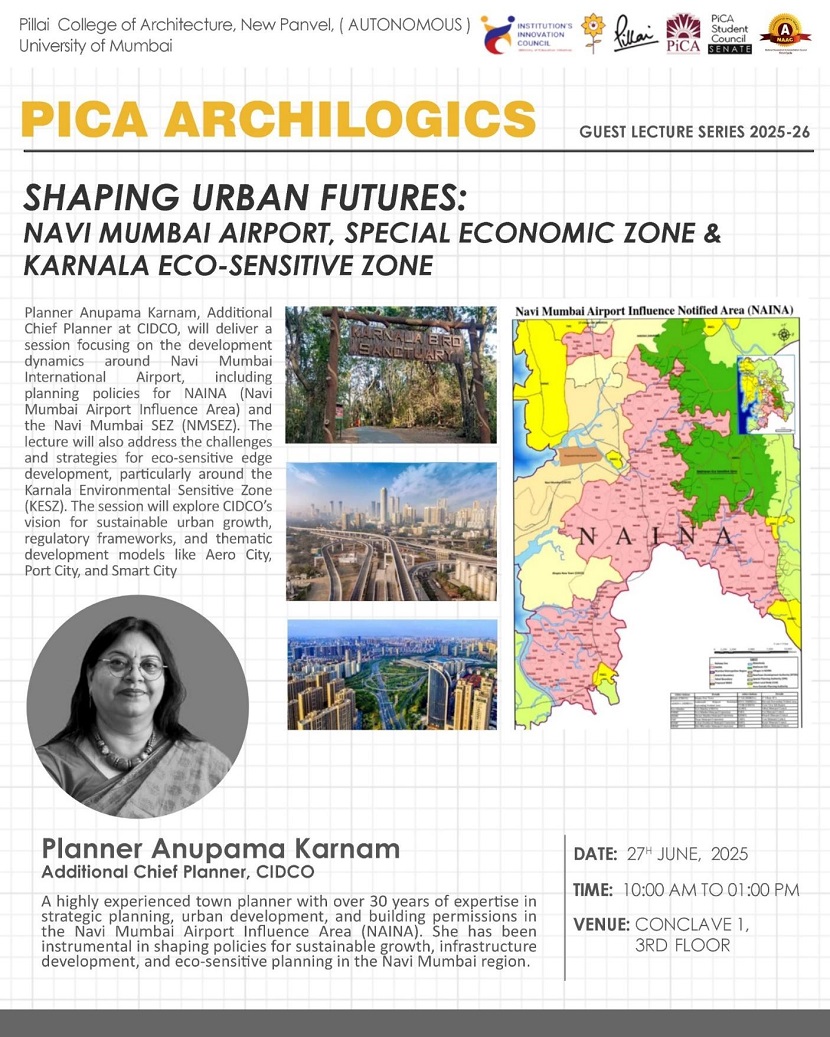| Event | Shaping Urban Futures: Navi Mumbai Airport, Special Economic Zone & Karnala Eco-Sensitive Zone |
| Year | 2025 - 2026 |
| Date | 27th July, 2025 |
| Time | 10:00 a.m. to 12:00 p.m. |
| Venue | 3rd Floor conclave |
| Faculty Co-ordinator | Prof Amruta Khairnar, Prof Sarojini Lahot, Prof. Aarti Mankame |
The Lecture was delivered by Planner Anupama Karnam, a renowned expert in strategic planning, urban development, and building permissions in the Navi Mumbai Airport Influence Area (NAINA). She has been instrumental in shaping policies for sustainable growth, infrastructure development, and eco-sensitive planning in the Navi Mumbai region.
The speaker opened the lecture by setting the historical and geographical context of Navi Mumbai’s growth trajectory, highlighting the role of CIDCO in urban planning and the strategic location of the upcoming Navi Mumbai International Airport (NMIA).
It began promptly at (10:00 a.m.), with the students from the field of Architecture. The event was inaugurated by Students and Faculties, who welcomed the Guests and highlighted the importance of conference theme: Shaping Urban Futures: Navi Mumbai Airport, Special Economic Zone & Karnala Eco-Sensitive Zone.
With a brief background on the topic and setting the tone for the discussions to follow, she emphasized current global challenges, recent developments, and the need of planning the cities of NAINA focussing on overall context of NAINA and Eco-Sensitive Zone.
The points covered:
- The vision behind the airport project and its catalytic impact on regional development.
- The establishment of Special Economic Zones (SEZs) aimed at boosting investment and employment.
- Environmental concerns have been raised due to the proximity of Karnala Bird Sanctuary and the designated Eco-Sensitive Zone (ESZ).
1. Navi Mumbai Airport and Regional Transformation
Discussed the transformative potential of the NMIA in terms of connectivity, economic spillovers, and land use change. Concerns over displacement, resource consumption, and urban sprawl were also raised.
2. Land Pooling Concept
The conference detailed how CIDCO adopted a land pooling model to develop infrastructure while sharing the benefits with the original landowners.
3. Reserved Pricing and its purpose
In the NAINA context, reserve price is likely a mechanism to ensure that land is sold at a price that reflects its value, considering the infrastructure development and planned amenities within the NAINA area.
Purpose of Reserve Price:
Prevent undervaluation: It helps prevent landowners from selling their plots at significantly lower prices than their market value.
One of the most forward-thinking aspects discussed during the conference was the shift toward theme-based planning within the NAINA framework. This planning strategy emphasizes designing urban areas around specific themes or functions, aligned with sustainability principles, economic potential, and local ecological contexts.
The conference concluded on an inspiring and forward-looking note, reinforcing the urgent need to balance rapid urban development with ecological responsibility.








